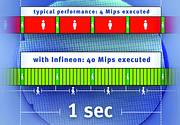
Infineon Technologies has introduced a chip design technology that allows a significant increase in the performance of embedded processors. This breakthrough in chip architecture, which Infineon calls MyVP (my virtual processor) technology, enables system designers to jump over the limitations of Moore's Law and achieve an increase of up to 10 times the efficiency of new processors, according to the company.
The typical progress of chip performance (referred to as Moore's Law), is based on the reduction in the size of transistors, which leads to a corresponding increase in computing power. But Infineon says its MyVP technology achieves its dramatic performance improvements by changing the way that embedded processors work, enabling a leap in performance without changing production technology.
The MyVP technology is based on a series of innovations that make it possible to use multithreading, a technique developed for high-performance computer systems, in embedded processors and digital signal processors, while maintaining or improving the realtime determinism required for embedded systems. Infineon's first Implementation of MyVP technology will be in a new 32-bit microcontroller that it plans to introduce in mid-2003. Infineon also plans to actively license MyVP technology to other chip designers to promote wide use of the technology.

Solving the memory problem
"Constant increases in clock rates are one effect of Moore's Law, and clock speed, or megahertz, has become popular as a general gauge of performance. But a processor runs no faster than memory, so speeding up the processor has no benefit when the fast chip is using program memory that runs at one-tenth its speed," said Robert Ober, Director of Microprocessor Architecture at Infineon Technologies. "MyVP technology helps to solve a performance problem that keeps getting worse over time, and creates a solution to the high cost of complex memory subsystems, radically more performance and lower cost."
According to Infineon, a 10 times improvement in performance can be seen in cost-sensitive embedded systems, where processors running at speeds of 400 MHz are paired with low-cost external Flash memory at 40 MHz. The processor can waste 90% of its time waiting for instructions from that slow memory. With MyVP technology, an embedded processor acts like multiple separate 'virtual' processors. When one processor task is forced to wait, the other 'virtual' processor takes over, efficiently using 100% of the chip's calculating resources, says the company.
In typical embedded systems, engineers make a trade-off between fast expensive memory chips and low-speed, low-cost memory. Tasks considered 'timing critical' use instructions stored in the fast on-chip memory, while all other tasks use instructions stored on separate, lower speed memory chips. While this memory problem is common to all types of computer systems, it is particularly acute in embedded systems (such as consumer electronics), where cost variations of less than a dollar can make the difference between success and failure. To control costs, designers try to reduce the amount of fast memory without sacrificing performance.
Infineon says that with MyVP technology, designers can reduce the cost of system memory while actually increasing performance. MyVP technology also includes techniques to maintain 'deterministic performance,' which is a requirement for a wide range of embedded system applications. Simply put, determinism means that a system can predictably execute certain tasks within critical nanosecond time spans.
Improving the way things work
Improving efficiency enables more capable systems running at lower speed and lower power levels, while also dramatically improving high-end system performance. For example, memory access delays can reduce the efficiency of the baseband processor in mobile phones by a factor of three; a processor designed to run at speeds of 150 MHz operates at an effective rate of 50 MHz. Using MyVP technology, engineers can design the phone using a processor chip with much lower clock speed, extending battery life and/or adding new features.
| Tel: | +27 11 458 9000 |
| Email: | [email protected] |
| www: | www.electrocomp.co.za |
| Articles: | More information and articles about Electrocomp |

© Technews Publishing (Pty) Ltd | All Rights Reserved